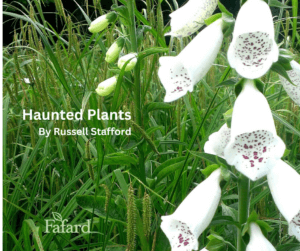
Halloween is over, except for a few stray candy bars and other remains. So why not get a jump on next year’s grotesquerie! Maybe what you need is a haunted perennial border, populated by plants with connections to the dark side. Plant some of the following, and you’ll have Halloween things happening in your garden from spring to October 31, and beyond.
Any haunted border worth its arsenic salt has black flowers. Lots of them. Not that any flowers are truly dead-on black. But some come close, sporting witchy shades of chocolatey midnight-brown that go deep into near-black territory. Mass them together in a goth border, or accent them with other haunted perennials in contrasting shades such as Eryngium giganteum ‘Miss Willmott’s Ghost’ and white foxgloves (Digitalis purpurea f. alba). And then enjoy, in a macabre sort of way.
Black hollyhock
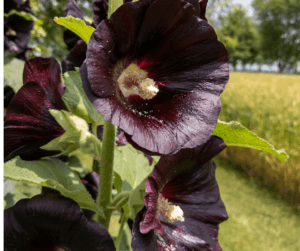
The large saucer- or pompon-shaped flowers of the beloved hollyhocks (Alcea rosea) typically come in cheerful shades of pink, red, and purple (with some whites and pale yellows thrown in). Not so in the case of ‘Nigra’, which broods over the border with its black-maroon blooms on 5-foot-tall stems. As with all forms of Alcea rosea, it’s a short-lived perennial that typically persists by seeding itself around. All hollyhocks are classic cottage garden plants, thriving in sunny, open locations. They like good drainage, so if your soil is compacted or heavy you’ll want to work in some organic matter such as Fafard® Premium Natural & Organic Compost.
Green Columbine
The petite flowers of the deceptively named green columbine (Aquilegia viridiflora) actually have deep chocolate-brown petals that verge on black, accented by silver-green sepals and spurs. They also depart from the Aquilegia norm in their early-spring bloom period and their fruity fragrance. Like black hollyhock, green columbine is a willing self-sower that favors moist, well-drained soil and looks well in cottage gardens and other informal plantings. At only 6 inches tall or so, it’s best in the foreground. Part to full sun in USDA in hardiness zones 4 to 8 work best.
Black Barlow Columbine
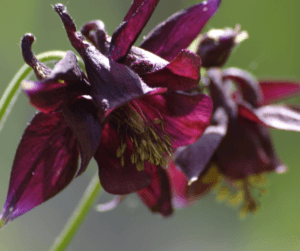
Black Barlow columbine (Aquilegia vulgaris var. stellata ‘Black Barlow’) is the dark star of the columbine tribe (the varietal name “stellata” means “starry”). Spurless blooms with ruffs of numerous whorled petals appear in late spring on 30-inch stems. Full to part sun and just about any decent soil will do, in zones 3 to 9. Like most columbines, ‘Black Barlow’ peters out after 2 or 3 years, but typically produces seedlings – which in its case are often true to form.
Dragon Arum
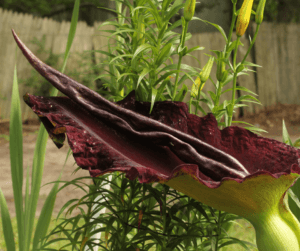
This is just the thing if you want to dial the “sinister” to level 11. The thick snake-skin stems of Dragon arum (Dracunculus vulgaris) arise to 2 feet or more from a large underground tuber in late spring, unfurling huge dragon-claw leaves. Topping each stem is a large triangular leaf-like “spathe”, colored green outside and deep maroon inside. It cowls a long sooty-black truncheon-shaped “spadix”, which takes the bizarre even further by emitting a potent carrion-like scent. Although tropical in appearance, this long-lived perennial is hardy to USDA Zone 5. It accepts full sun, but often does best with some shade, particularly in areas with hot summers.
Black Widow Geranium
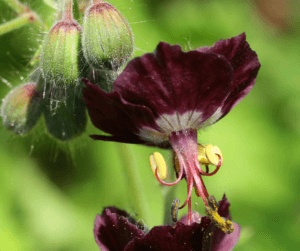
What better to haunt your garden than a black widow (Geranium phaeum)? Deep purple flowers with backswept petals nod broodingly over hummocks of five-lobed leaves in mid-spring, on 18-inch stems. In the variety ‘Samobor’ the dark shades also invade the leaves, which have large black-maroon blotches. Naturally, black widow prefers quite a bit of shade. Hardiness is from zones 4 to 8.
Lenten Rose

Correction, Robert Frost. Nature’s first green is black, if we’re talking the late-winter flowers of ‘Dark and Handsome’, Winter Jewels® Black Diamond Hellebore, or any of the several other Lenten rose (Helleborus × hybridus) cultivars that have gone over to the dark side. The central boss of pale golden stamens only adds to the spookiness. The flowers arise as early as February on 18-inch stems clad with bold, fingered, near-evergreen leaves. These shade-lovers will take quite a bit of sun if the soil is reasonably moist, and they’ll endure a wide range of temperatures (zones 4 to 9), given the right niche.
Black Rampion
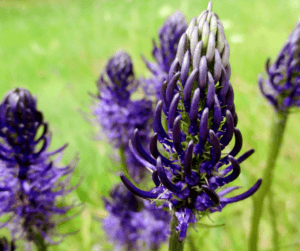
Black and spidery pretty much sums up the look of the frizzy conical flower heads of the European native, Black Rampion (Phyteuma nigrum). They are individually borne on 10-inch stems in late spring and early summer, over rosettes of arrow-shaped leaves. All parts of the plant are edible and have been traditionally used as such across much of their native range. Black rampion does best in full to part sun and well-drained soil in zones 5 to 9. It often self-sows.
Dwarf Black False Hellebore
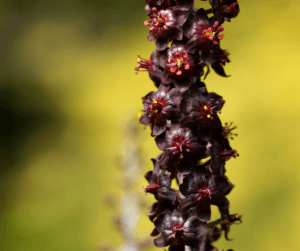
Frothy 18-inch flower spikes in early summer and tussocks of grassy basal leaves make for a far different look than that of the “true” hellebores described above (to which they’re not related). One thing they do share is the dark pigmentation of their blooms (of course). Although native to Taiwan, Veratrum formosanum is remarkably cold-hardy, to USDA zone 4. Plants do best with a bit of shade and soil that’s not too dry or soggy. Volunteer seedlings often happen, if you don’t deadhead the spent flowers.
Bowle’s Black Viola
Black-flowered variants occur quite often in the Viola tribe and Viola ‘Bowle’s Black’ is one of the best. This heirloom variety is one of the best, continuously producing dainty velvety black, yellow-eyed flowers. Although short-lived, it persists by seeding itself, not prolifically but more than adequately.

